- This module covers the 15 slug species which warrant watching for. These are all species which have been introduced in the Pacific Northwest and may be introduced to the state. Introductions are accidental occurrences, mostly by hitchhikers on nursery stock or vehicles transported into the state.
- Twelve species or species groups are already found in the state, the other two have not been reported in Alaska yet and are highlighted with an *.
- The most common slug found in Alaska, Deroceras reticulatum, the Grey Garden is common anywhere people garden and is found across the state North to the Brooks range. This species should only be reported in Northern or very remote situations.
This table helps determine if a slug should be reported. Because many species are naturalized and populations are well known it’s not always necessary to report all slugs seen. Descriptions of the species are below.

Grey Garden Slug
Deroceras reticulatum

General Description
The grey garden slug is the most common slug found in Alaska. It occurs across the state from the Brooks range south. The pneumostome is located near the rear of the mantle. Adults will reach 50 mm, but most slugs encountered are smaller in the 20-35 mm range. They are generally a mottled grey to tan, with a brown head region. The mantle has concentric rings, almost like a fingerprint, encircling the pneumostome.
Identification
There are several other Deroceras species found in the state, and dissection may be required to verify identification. Most instances where a small grey or tan slug is encountered will be D. reticulatum.
Impact
This species has the ability to reach very large population sizes. Large numbers can be very damaging to crops. They are especially damaging to leafy greens and cabbage, but can also damage ground vegetables like carrots, turnips, and potatoes. They generally prefer living material, but will feed on freshly cut vegetation, fungi, and occasionally dead slugs or feces.
Management
Control of this species is very difficult. Although often encountered in altered environments, like gardens or lawns, they are very common in natural settings like glens as well. Identifying the source population and installing a barrier around desirable vegetation is the most effect way to reduce damage.
Where to look
Everywhere. They are very common in lawns and hay fields, but also in forest edges and glens all throughout the boreal forest around Southcentral. They are more numerous in developed environments in Southeast, but can be very numerous in forested settings as well. Further north in the state they appear to be more restricted to areas where people are farming and gardening.
Other resources
https://agsci.oregonstate.edu/slug-portal/life-slug/biology-and-life-cycle-gray-field-slug
Black Slug
Arion ater, A. rufus, A. vulgaris
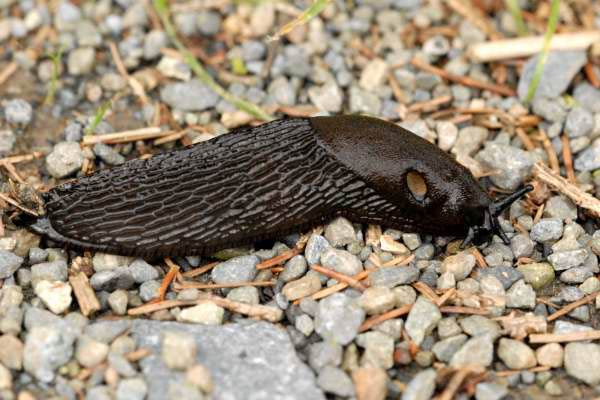
General Description
Three species of Black slugs may exist in Alaska. Black slugs are identified by the location of the pneumostome, which is located on its right side and is in the front half of the mantle. They have large prominent ridges running along their dorsum called tubercles. They also lack a keel on the dorsum. They are a large slug, up to 180 mm, generally black, but may be dark red and even occasionally white but monochromatic.
Identification
Separation of the three species requires dissection or molecular resources. All three species can hybridize which also make identification difficult. This group can be identified from other Arion species by their large size and uniform color. These species are also coprophagous, eats poop, and often found around dog walking areas.
Impact
Damage of these species is generally limited to gardens and agricultural settings where the slugs can be major pests of spring seedlings and fall leafy green crops. Their impact in other natural habitats is unknown, but they likely compete with native species.
Management
For commercial operations, spring treatment with molluscicides can be helpful. Barriers have the most potential for limiting slug movement.
Where to look
These species occur in more temperate, moist areas of the state. They are very common in Southeast and Prince William Sound, and have spread out to the Alaska Peninsula as well. They are occasionally found in the Anchorage and Mat-su Valley area.
Other resources
https://agsci.oregonstate.edu/feature-story/red-slug-arion-rufus
https://en.wikipedia.org/wiki/Spanish_slug
https://idtools.org/mollusk/index.cfm?packageID=1178&entityID=8186
https://www.bbc.com/news/world-europe-49164416
Garden Slug
Arion hortensis, A. distinctus

General Description
These slugs are identified by the location of the pneumostome, which is located on its right side and is in the front half of the mantle. They also lack a keel on the dorsum. Adult slugs will be about 30 mm. Garden slugs are gray or brown to black above, with a poorly-defined dark band on each side. It has a yellow, orange, or reddish sole, and a yellow or orange mucus color (which colors the sole).
Identification
Separation of the species requires dissection or molecular resources. They can be separated from similar Arion species by their small size, yellow sole, and colored foot mucus.
Impact
They are generally found in low densities but can be very destructive to small gardens.
Management
Hand removal and killing has been found to be the most effective for small areas. Xeric barriers such as asphalt, gravel, or vegetation free zones, may also be effective.
Where to look
Currently only known from Sitka.
Other resources
Dusky Arion
Arion subfuscus, A. fuscus
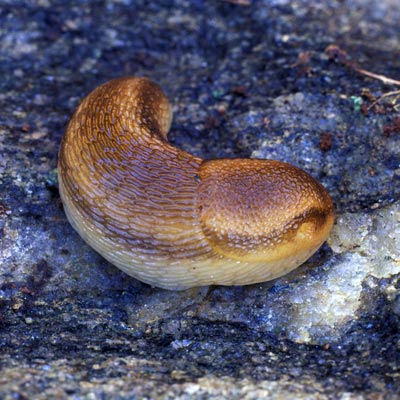
General Description
These slugs are identified by the location of the pneumostome, which is located on its right side and is in the front half of the mantle below the lateral dorsal stripe. They also lack a keel on the dorsum. Adult size is no more than 70 mm. Coloration varies but is usually reddish -brown black to orange and even yellow. They often have a pair of dusky bands laterally.
Identification
Identification of the species requires dissection or molecular resources. They can be separated from other Arion species by their banding and moderate size and the fine vertical stripes on the foot fringe. Additionally, defensive mucus is often yellow.
Impact
They are common pests of home gardens.
Management
Hand removal and killing has been found to be the most effective for small areas. Xeric barriers may also be effective.
Where to look
They are generally found in urban gardens across the more temperate areas of the state from Southeast to the Alaska Peninsula.
Other Resources
https://idtools.org/mollusk/index.cfm?packageID=1178&entityID=8197
https://mlbs.virginia.edu/organism/arion_subfuscus
https://animaldiversity.org/accounts/Arion_subfuscus/
False Keel Slug
Arion circumscriptus, A. silvaticus
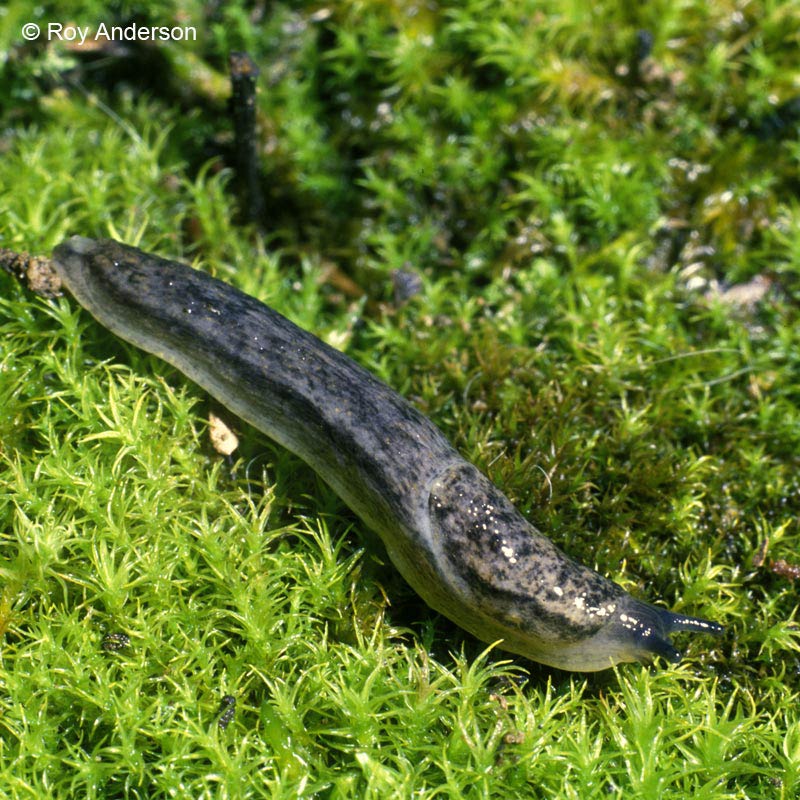
General Description
These slugs are identified by the location of the pneumostome, which is located on its right side and is in the front half of the mantle. They also lack a keel on the dorsum, but have a row of tubercles which may appear as a keel. Adults are usually 30-40 mm, greyish centrally and white laterally with a pair of dark-colored longitudinal stripes. They have black speckled markings on the mantle and the tentacles in A. curcumscriptus, but may be absent in A. silvaticus, but these features are variable. The sole and foot fringe is pale colored, mucus is colorless or occasionally pale yellow.
Identification
Identification of the species requires dissection or molecular resources. They can be separated from other Arion species by their small size and dark body color which contrasts with a white sole.
Impact
They are common spring seed grass pests in the Pacific Northwest. In Alaska they have only been reported from Sitka, where the potential to be a spring seedling pest exists.
Management
Hand removal and killing has been found to be the most effective for small areas. Xeric barriers may also be effective.
Where to look
They are known from urban gardens in Sitka. They are likely in many communities in Southeast.
Other Resources
https://idtools.org/mollusk/index.cfm?packageID=1178&entityID=8189
Milky Slug
Deroceras agreste
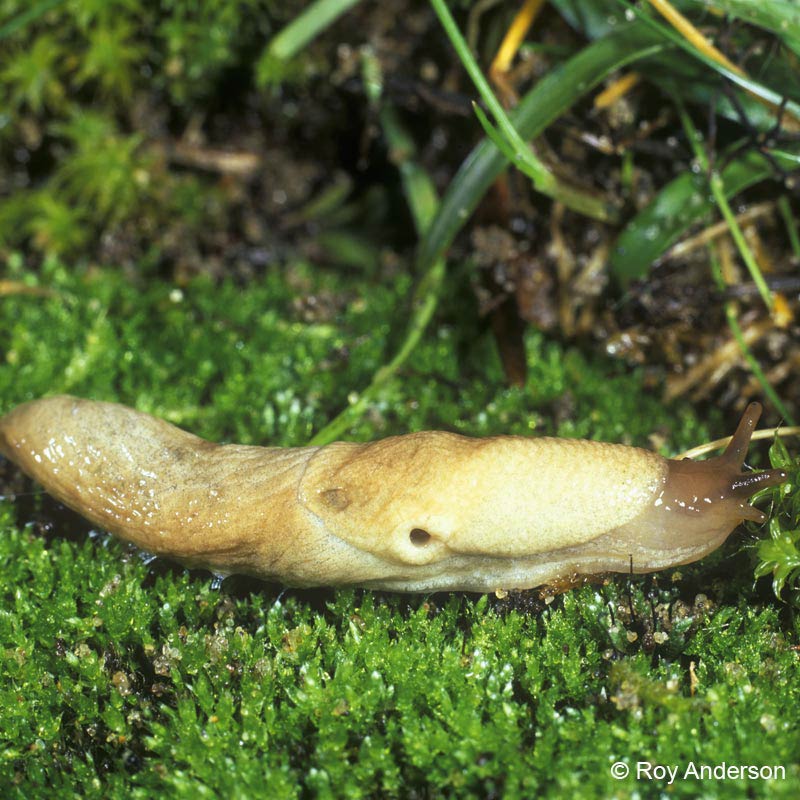
General Description
The pneumostome is located to the rear of the mantle and may be pale and unspotted. Adults are usually 20–35 mm long. Slugs are light greyish-brown to almost black, with the skin appearing watery and fairly transparent. Close inspection reveals fine dark spotting usually over the whole body. The mucus is clear.
Identification
This species can be separated from the native Meadow Slug, D. laeve, by its lighter color and larger numbers. It can be separated from D. reticulatum by its smaller size and more uniform grey color. Dissection can be used to verify identification as well.
Impact
When present this slug can be very numerous and damaging to a variety of crops from barley and pasture to other soil food crops like potatoes, carrots and leafy greens.
Management
Hand removal and killing has been found to be the most effective for small areas. Xeric barriers may also be effective.
Where to look
These slugs can be found in any moist environment and will generally feed on a wide variety of leafy plants and ferns. They can be common in gardens, and can be agricultural pests.
Other Resources
https://idtools.org/mollusk/index.cfm?packageID=1178&entityID=8208
Leopard Slug
Limax maximus
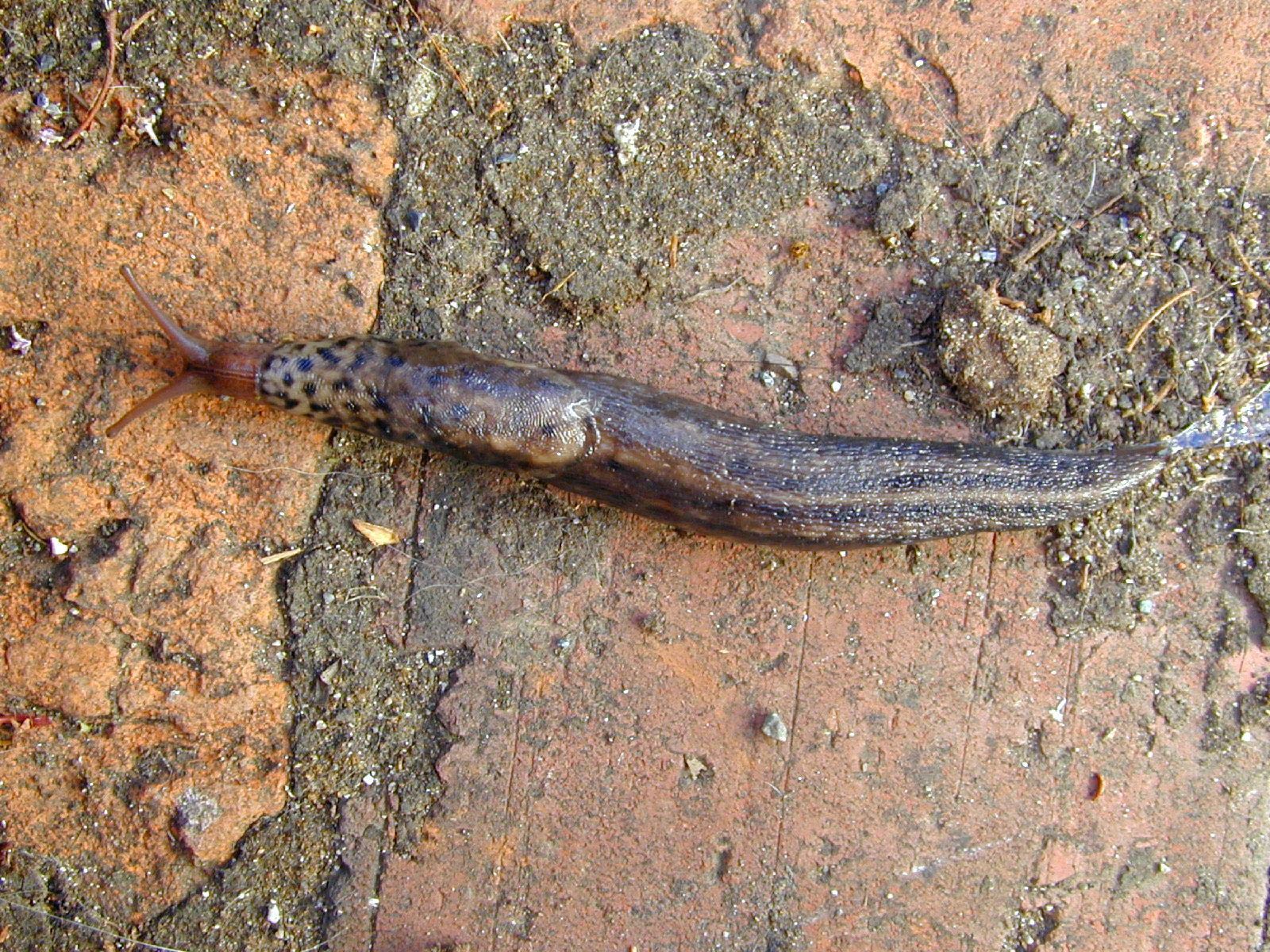
General Description
Adult specimens are large 150-200 mm in size. Generally, they are a light greyish or grey-brown with darker spots and blotches, although the coloration and exact patterning of the body of this slug species is quite variable. The pneumostome is located posteriorly on the mantle.
Identification
This species is distinctive. It is the only large slug with a leopard spot or stripped color pattern.
Impact
The impact of the species is not known. They are uncommonly reported, and large numbers are not known of.
Management
Slugs can be hand collected and destroyed.
Where to look
These slugs can be found in any moist environment and will generally feed on a wide variety of leafy plants and ferns, and may prey on other slugs. They are not gregarious and are rarely considered pests. They occur across Alaska, south of the Alaska Range.
Other Resources
https://en.wikipedia.org/wiki/Limax_maximus
https://idtools.org/mollusk/index.cfm?packageID=1178&entityID=8229
Three Banded Garden Slug
Ambigolimax valentianus

General Description
Adults are about 50-75 mm. Overall coloration is translucent and has a yellow-grey or yellow-violet color with two pairs of dark bands on either side of the body’s midline. The lower pair of bands may be faint. The sole of the slug is pale grey. The keel is short and does not extend to mantle. The mantle has multiple ridges with what appears to be a fingerprint-like pattern. The pneumostome is located on the posterior third of the mantle. Mucus is clear and watery.
Identification
Body has two dark tram lines running along both the mantle and body. Adults are much smaller than the Leopard slug.
Impact
Common pest of greenhouses and urban gardens. Often found clustered together in groups. Pests of ornamentals like orchids.
Management
Slugs can be hand collected and destroyed. Infestations can be difficult to contain in artificial environments with suitable hiding places.
Where to look
These slugs can be found in any moist environment and will generally feed on a wide variety of leafy plants and ferns and may consume decaying wood. This slug has been found on nursery stock.
Other Resources
https://en.wikipedia.org/wiki/Ambigolimax_valentianus
https://idtools.org/mollusk/index.cfm?packageID=1178&entityID=8225
Brown Field Slug *
Deroceras invadens (synonym = D. panormitanum)

General Description
The pneumostome is located to the rear of the mantle and may be pale and unspotted. Adults are usually 20–35 mm long. Slugs are light greyish-brown to almost black, with the skin appearing watery and fairly transparent. Close inspection reveals fine dark spotting usually over the whole body. The mucus is clear.
Identification
This species is easily confused with D. laeve and D. agreste. It can be separated from D. leave by the light ringed pneumostome and the tail is longer than the mantle. It can be separated from D. agreste by the dark color. Dissection is also useful for ID confirmation.
Impact
These slugs can be pests or ornamentals, pasture and fall food crops.
Management
Hand removal and killing has been found to be the most effective for small areas. Xeric barriers may also be effective.
Where to look
These slugs can be found in any moist environment and will generally feed on a wide variety of leafy plants and ferns. They can be common in gardens, and can be agricultural pests. Found throughout the Pacific Northwest and Coastal Western Canada. It has not been reported in Alaska.
Other Resources
https://idtools.org/mollusk/index.cfm?packageID=1178&entityID=8211
https://en.wikipedia.org/wiki/Deroceras_invadens
Yellow Cellar Slug *
Limacus flavus

General Description
Adult slugs are yellow to a grey-green color. Tentacles are pale bluish or bluish black in color. Adults range in length from 75 to 115 mm. The mantle is oval and has ridges that appear to have a fingerprint-like pattern on it. The pneumostome is surrounded by a lighter halo and located on the rear of the mantle. The sole of the foot is yellow-white. Body mucus is yellowish and very adhesive, foot mucus is colorless. This species has been found to carry the nematode Angiostronglyus cantonensis which can cause eosinophilic meningitis. Humans can pick up the nematode through ingestion of the slugs, or through contaminated water or vegetables.
Identification
Large, up to 130 mm, yellow green or yellowish brown slug with a centrally located broken pale stripe. Tentacles are a blue or black color and contrast body color.
Impact
Damage stored goods and produce. May also feed on ground crops in gardens.
Management
Individual slugs can be hand collected and destroyed. Xeric barriers and an effective monitoring plan will help limit exposure.
Where to look
This species occurs in diverse habitats ranging from compost piles, gardens and woodlands to greenhouses. This species is working up the West coast and is currently found in California.
Other Resources
https://en.wikipedia.org/wiki/Limacus_flavus
https://idtools.org/mollusk/index.cfm?packageID=1178&entityID=8227
